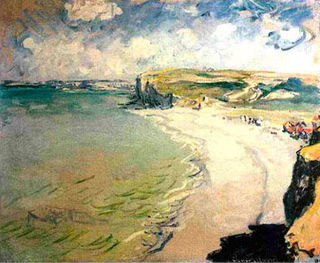
Claude Monet: "Beach in Pourville"(1882)
Sound
plays an important role in the movement and atmosphere of Mary Robinson’s “The
Haunted Beach”, and it also serves to create a sublime setting. Coupled with
instances of personification, the sounds of the poem hint at a deeper mystique
and power working through the natural and inanimate, from the cliffs to the
ocean itself. Even more, the sounds (or lack thereof) that the humans make are
unusual and contrast with the noises of the inanimate. In all, the audible
points of this poem – and who or what supplies them – reveal a powerful form of
communication, even one devoid of human-constructed words.
Personification
and sound go hand in hand throughout the poem. In the first line, to be exact,
the beach is described as “lonely” (l. 1), a characteristic that already
depicts human unrest and isolation. Two lines following this description, the
shed is given a “head” (l. 3), and in the next stanza, a cavern wide is supplied
with jaws (ll. 15-16). Fittingly, both jaws and a head are gateways to
communication, and at the least, they join the chorus of personified yet
naturally-occurring features on the beach. Certainly, the most prominent of
these is the ocean, with its green billows that “play’d”, as referenced six
times during the poem. The sublime, then, is allowed to manifest through the
personification of otherwise inanimate bodies.
The
ocean engages in two forms of discourse: roaring and yawning. Each of these come
from a mouth but have different meanings. Yawns usually exude tiredness, a lack
of interest or boredom, and what is more, they can be attempts to energize the
body and gain more oxygen. Roaring is much more beast-like and is a total
emission – a release of epic, loud proportions. That the ocean balances between
these disparate sounds signals the awe and epic nature of the scene. As
expressed in the first stanza, the green billows produce “the deafening roar
/re-echoed on the chalky shore” (ll. 7-8), and the interplay with a “chalky”
surface seems intentional, as to intimidate human instrumentation of language.
This cross blend of communication and nature is also present earlier in the
stanza, as “lofty barks were shatter’d” (l. 4), with the word “barks” playing
on both trees and the talking or noise made by outsiders, lofty and separated
from the beach.
The
apparitions are termed a “band/ of spectres” (ll. 25-26), which may also supply
a musical connotation in addition to one of camaraderie. This would also be an
interesting addition to the conversation between the ocean and outsiders, as
the green billows “play”, perhaps musically. Unlike the winds that moan, the
spectres howl, which is a decidedly less humanistic verb. In relation to the
ghosts, the ocean exudes the same power of its “deafening roar” (l. 7), but does
so with its “yawning” (l. 55), in which “the spectre band, [the mariner’s]
messmates brave, /Sunk” (ll. 54-55). With the sound of this yawn, as defined
earlier, the ocean both exudes its lack of concern for the humans, and perhaps
attempts to re-energize itself.
Of
course, the green billows are in conversation with other elements. For example,
“the moaning wind / Stole o’er the summer ocean” (ll. 19-20), with the moaning
again signaling both personification and unrest. Moreover, as the ocean yawns
late in the poem, the storm above produces a “commotion” (l. 57). This
continued implementation of unsettling noises could be a precursor to the dark
murder of the mariner. Even more, it is arguable that the silence of the
fisherman/murderer dehumanizes him in the poem and strips him of his ability to
express or emote. In addition, the silence could be symbolic of how the
expressive natural world has supplanted him.
Sadly
for the fisherman, it seems an unhappy partnership, as his “liquid way/ bounds
over the deeply yawning tomb” (ll. 69-70). The tomb is not pleased; rather, it
yawns and almost seems like the embodiment of an unenthused master. Perhaps,
this theory of natural dominance over the humans (the fisherman and the
apparitions) explains the dreary servitude the murderer inhabits in the final
stanza. No explanation is perfect, but what can be ascertained is the dramatic
role sound and personification play in the sublime setting of Mary Robinson's “The Haunted
Beach”.
I think this is a really compelling reading of the poem. Nature is often a sublime aspect of Gothic literature because of its dominance over humans through the power and destruction that it is capable of, and its ability to make us feel insignificant as only a very small part of the world. Robinson's personification of nature draws this out. It is interesting that she decides to give a cavern jaws because not only can jaws produce communication, but they can also shut tightly, and if you walk into this cave, it could trap you inside "the belly of the beast" so to speak. In addition, the constant personification of nature juxtaposed with the dehumanization of the dead shows us that it lives on, even when we do not, which only reinforces the idea of our insignificance according to Gothic ideas.
ReplyDelete